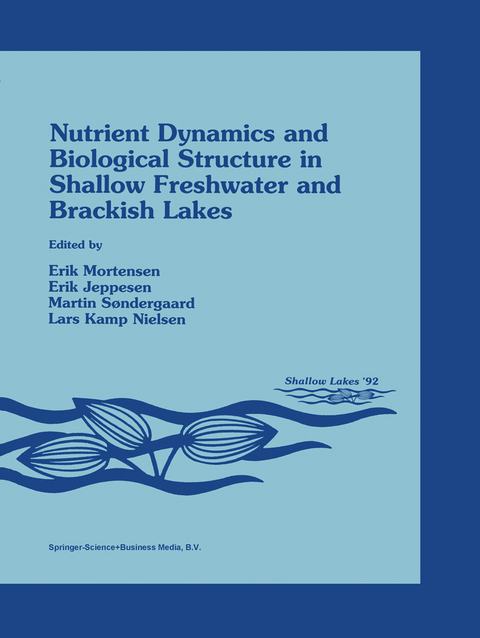
Nutrient Dynamics and Biological Structure in Shallow Freshwater and Brackish Lakes
Springer (Verlag)
978-90-481-4360-3 (ISBN)
The volume is divided into five main themes, each introduced by an invited speaker:
Nutrient dynamics with special emphasis on sediment water interactions and changes in loading (Professor Lambertus Lyklema);
Biological structure and trophic interaction (Professor Stephen T. Threlkeld);
Submerged macrophytes: dynamics and role in the lake ecosystems (Ass. Professor Kaj Sand Jensen);
Comparison of freshwater and brackish lake ecosystems (Professor Brian Moss);
Modelling the impact of nutrients, the biological structure and the recovery process (Dr Marten Scheffer).
Brackish and freshwater shallow lakes — different systems or variations on the same theme?.- Does the impact of nutrients on the biological structure and function of brackish and freshwater lakes differ?.- The consequences of a drastic fish stock reduction in the large and shallow Lake Wolderwijd, The Netherlands. Can we understand what happened?.- Trophic interactions in a shallow lake following a reduction in nutrient loading: a long-term study.- Top-down control of phytoplankton in a shallow hypertrophic lake: Little Mere (England).- Food web manipulation in a small eutrophic Lake Wirbel, Poland: effect of stocking with juvenile pike on planktivorous fish.- Environmental effects of introducing whitefish, Coregonus lavaretus (L.), in Lake Ring.- Predator—prey relationships within the pelagic community of Neusiedler See.- Ecological interactions in a shallow sand-pit lake (Lake Créteil, Parisian Basin, France): a modelling approach.- Ecological models and the pitfalls of causality.- Long-term compositional response of phytoplankton in a shallow, turbid environment, Neusiedlersee (Austria/Hungary).- The time course of phytoplankton biomass and related limnological factors in shallow and deep lakes: a multivariate approach.- Long-term phytoplankton changes in a shallow hypertrophie lake, Albufera of Valencia (Spain).- Population dynamics of Limnothrix redekei, Oscillatoria lanceaeformis, Planktothrix agardhii and Pseudanabaena limnetica (Cyanobacteria) in a shallow hypertrophic lake (Spain).- Polymixis of a shallow lake (Grosser Müggelsee, Berlin) and its influence on seasonal phytoplankton dynamics.- Influences of the lowland river Spree on phytoplankton dynamics in the flow-through Lake Müggelsee (Germany).- Relationship between trophic state and planktoncommunity structure in 21 Sicilian dam reservoirs.- Submerged macrophytes in the recently freshened lake system Volkerak-Zoom (The Netherlands), 1987–1991.- The influence of ammonia on the growth and photosynthesis of Ruppia drepanensis Tineo from Doñana National Park (SW Spain).- Colonization and succession of submerged macrophytes in shallow Lake Væng during the first five years following fish manipulation.- Restoration of Botshol (The Netherlands) by reduction of external nutrient load: recovery of a characean community, dominated by Chara connivens.- Nutrient cycling in shallow, oligotrophic Lake Kvie, Denmark. I: Effects of isoetids on the exchange of nitrogen between sediment and water.- Nutrient cycling in shallow, oligotrophic Lake Kvie, Denmark. II: Effects of isoetids on the exchange of phosphorus between sediment and water.- Can Chara control phosphorus cycling in Lake ?uknajno (Poland)?.- Phosphorus fluctuation in water and deposition into sediment within an emergent macrophyte stand.- Benthic—pelagic interactions in shallow water columns: an experimentalist’s perspective.- Fish interactions with the sediment—water interface.- The role of zoobenthos in energy flow in two shallow lakes.- Colonization and succession of macroinvertebrates in recently freshened Lake Volkerak-Zoom (The Netherlands).- Nutrient dynamics in shallow lakes: effects of changes in loading and role of sediment—water interactions.- Kinetics of luxury uptake of phosphate by algae-dominated benthic communities.- Nutrient balances and phytoplankton dynamics in two agriculturally loaded shallow lakes.- Effect of summer weather on internal loading and chlorophyll a in a shallow lake: a modeling approach.- Influence of internal loading on phosphorus concentration in shallow lakesbefore and after reduction of the external loading.- A diatom-phosphorus transfer function for shallow, eutrophic ponds in southeast England.- Recent palaeolimnology of three shallow Danish lakes.- Alum treatment effectiveness and longevity in shallow lakes.- Effects of hypolimnetic water aeration and iron-phosphate precipitation on the trophic level of Lake Krupunder.- The importance of sediment phosphorus release in the restoration of very shallow lakes (The Norfolk Broads, England) and implications for biomanipulation.- Long-term responses to fish-stock reduction in small shallow lakes: interpretation of five-year results of four biomanipulation cases in The Netherlands and Denmark.- Lake Horowhenua: a computer model of its limnology and restoration prospects.- Mathematical modelling as a tool for management in eutrophication control of shallow lakes.- Factors affecting light penetration in shallow lakes.- Water quality management in the River Gudenaa, a Danish lake—stream—estuary system.
| Reihe/Serie | Developments in Hydrobiology ; 94 |
|---|---|
| Zusatzinfo | 42 Illustrations, black and white; IX, 507 p. 42 illus. |
| Verlagsort | Dordrecht |
| Sprache | englisch |
| Maße | 210 x 279 mm |
| Themenwelt | Naturwissenschaften ► Biologie ► Limnologie / Meeresbiologie |
| Naturwissenschaften ► Biologie ► Ökologie / Naturschutz | |
| ISBN-10 | 90-481-4360-8 / 9048143608 |
| ISBN-13 | 978-90-481-4360-3 / 9789048143603 |
| Zustand | Neuware |
| Haben Sie eine Frage zum Produkt? |
aus dem Bereich


